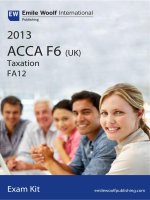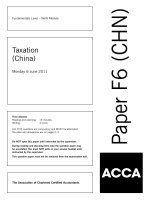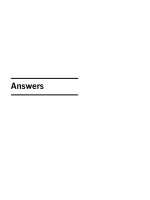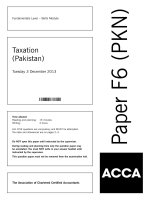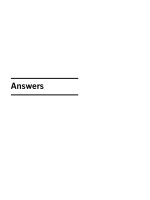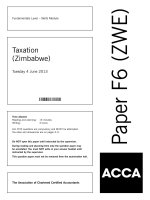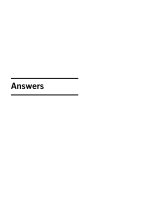ACCA f6 taxation south africa 2013 jun answer
Bạn đang xem bản rút gọn của tài liệu. Xem và tải ngay bản đầy đủ của tài liệu tại đây (202.77 KB, 9 trang )
Answers
Fundamentals Level – Skills Module, Paper F6 (ZAF)
Taxation (South Africa)
June 2013 Answers
and Mark Scheme
Note: ACCA does not require candidates to quote section numbers or other statutory or case references as part of their answers.
Where such references are shown below [in square brackets] they are given for information purposes only.
Marks
1
Mrs Rina Janse van Rensberg
(a)
The two tests are:
Ordinarily resident (the legal subjective test); or
Physical presence (the objective test).
½
½
Essentially the test for a person being ordinarily resident rests on a number of subjective factors, such as place
of economic and family interests. Case law provides the criteria that the place of ordinary residence is the place
to which a person would return from their wanderings despite absences of long or short duration.
½
1
The physical presence test is only used where a person is not ordinarily resident during a year of assessment.
It deems a person to be resident where that person has spent:
More than 91 days in South Africa in the current year of assessment; AND
More than 91 days in South Africa in each of the five preceding years of assessment; AND
In aggregate has spent more than 915 days in South Africa over the preceding five years of assessment.
The tests do not apply where a person is deemed exclusively resident of another country by virtue of a double
tax agreement.
13
½
½
½
1
–––
5
–––
Marks
(b)
Employees tax withheld and paid
R
Cash salary R4,000 x 12
Fee earned for training delivered – R5,000 x 100 days
Tablet device would not be taken into account by her employer.
Mobile phone – fringe benefit arises as it is not used mainly (i.e. more than
50%) for business purposes
No objective evidence of percentage use and so no reduction.
1
60,000
½
½
68,571
25,000
1,500
––––––––
95,071
––––––––
23,768
1
½
½
598·4 cents
133·6 cents
1
½
1
–––––––––––
732·0 cents
–––––––––––
36,600
(36,600)
Balance of remuneration
Tax on R527,690 per the tables
Less primary rebate for persons under 65
Less medical contribution rebate:
[R460 (member plus first dependant) + R154 (next dependant)] x 12 months
14
½
(60,000)
––––––––
501,000
Total costs
Employees tax withheld and paid to SARS
13,000
½
½
½
Add net travel allowance:
Allowance received – R5,000 x 12
Business kilometres for both options is 5,000.
Option 1: Actual costs
Wear & tear (limited to) R480,000/7 years
Fuel
Other costs
Reduction: R7·320 x 5,000 kms
Best reduction is therefore option 2
Net allowance inclusion
Net subsistence allowance inclusion
Days allowance received (70) x rate (R350)
No record of expenses kept, therefore use deemed rate of
R303 x 70 days
½
½
––––––––
561,000
Sub-total
Contribution to retirement annuity fund:
Actual – R60,000 limited to greater of:
R1,750; or
R3,500 – R0; or
15% x R561,000 (being 15% of non-retirement funding
income) = R84,150
Reduction R95,071 x 5,000 kms/20,000 kms
Option 2: Deemed costs
Fixed cost per km: R119,683/20,000 kms
Fuel rate
Maintenance rate (none incurred as maintenance plan exists)
R
48,000
500,000
½
23,400
24,500
(21,210)
––––––––
½
½
3,290
––––––––
527,690
––––––––
½
145,002
(11,440)
½
½
(7,368)
––––––––
126,194
––––––––
1½
–––
14
–––
Marks
(c)
Normal tax liability
R
Remuneration before RAF contribution (from above)
Wear & tear on tablet device (permitted for employed persons) –
R8,900/3 x 10/12
(2,472)
––––––––
558,528
Contribution to retirement annuity fund:
Actual – R60,000 limited to greater of:
R1,750; or
R3,500 – R0; or
15% x R558,528 (being 15% of non-retirement funding
income) = R83,779
Add net travel allowance (from above)
Add net subsistence allowance (from above)
Investment income
Foreign dividends
Reduced by general foreign dividend exemption 25/40 x R13,000
Less medical deduction:
Employee contributions R3,000 x 12
Reduced by 4 x rebate 4 x R7,368 (see above)
Qualifying contributions
Add other qualifying medical expenses:
Costs incurred
Qualifying medical costs
The qualifying costs are not reduced as Rina has a disabled dependant
Taxable income
Tax per the tables
Less rebate (primary only as less than 65 years of age)
Less medical rebate
Total normal tax
Less employees tax
Refund due
2
R
561,000
½
1
½
½
½
(60,000)
––––––––
498,528
23,400
3,290
13,000
(8,125)
–––––––
4,875
––––––––
530,093
1
½
½
½
½
36,000
(29,472)
–––––––
6,528
½
1
28,000
–––––––
34,528
½
(34,528)
––––––––
495,565
––––––––
1
132,795
(11,440)
(7,368)
––––––––
113,987
(126,194)
––––––––
(12,207)
––––––––
½
½
½
½
–––
11
–––
30
–––
Science Co Ltd
(a)
–
A company, as a non-natural person, is considered to be resident for income tax purposes where it is
incorporated, formed, established or has its place of effective management in South Africa.
–
The tests of incorporation, formation or establishment are simple, objective, fact based tests and easily
determinable from the records of the company.
–
The test for ‘place of effective management’ is more subjective, but is still based on an analysis of the facts
related to the operations and decision-making powers within the company. Essentially, the South African
Revenue Service (SARS) considers the ‘day-to-day’ decision-making powers to be decisive as regards the
identification of the place of effective management.
–
There is no definition for ‘day-to-day decision-making powers’ and so it remains a debatable point.
–
These tests are all overridden if the company is deemed to be exclusively resident of another country by
virtue of the application of a double tax agreement.
Note to marker: 1 mark for each point, maximum of 3 available for this part.
15
3
–––
Marks
(b)
R
(i)
Sales
Cash value of suspensive sale arrangements:
R2,350,000 x 100/114 x 5 arrangements
Finance charges earned: [(R2,350,000 less deposit R150,000)
x 5 arrangements x 1·08%]
[Tutorial note: The suspensive sales are instalment credit agreements
for VAT purposes. As a result the VAT output is recognised on the sale
based on the cash cost. There is no VAT on the finance charges as this
is a financial service and therefore an exempt supply.]
Debtors allowance
(R2,350,000 – 150,000 – 50,000) x 100/114 x 17%
(ii) Cost of sales
(iii) Allowance on machine to be replaced: R2,000,000 x 20% (fourth and
final year of allowance)
Recoupment:
Selling price
Limited to cost price
Less tax value (40%:2010; 20%:2011; 20%:2012;
20% (above):2013)
Recoupment to be deferred
Capital gain or capital loss:
Proceeds
Less recoupment
Less base cost:
Expenditure less allowances permitted
(2,000,000 – 2,000,000)
Capital gain to be deferred
(iv)
(v)
(vi)
(viii)
&
(ix)
(x)
(vii)
(iii)
Allowance on replacement machine: R4,000,000 x 40%
Recognised portion of recoupment of old machine: 40% x R2,000,000
Current insurance premium (1 December 2012) provides cover
extending more than six months after the end of the year of assessment
and must be allocated to the correct period: R350,000 x 4/12
Similarly the amount incurred in the prior year would have to be spread
over the appropriate year of assessment: R310,000 x 8/12
Current year doubtful debts allowance: R1,500,000 x 25%
Reversal of prior year doubtful debts allowance: (R1,300,000 –
R10,000 (amount not previously in gross income)) x 25%
Bad debts written off (allowance): R170,000 – R10,000 (not
previously in income)
Other tax deductible expenses – given
Expenditure pertaining to research and development (as defined):
R2,000,000 technical staff salaries + R500,000 other expenditure
plus R450,000 capital expenditure = 2,950,000
Allowance permitted: 100% of expenditure
Further allowance permitted (as R&D projects approved by the Minister
of Science and Technology) 50% x R2,950,000
Marketing is excluded from the scope of R&D and therefore does not
qualify for R&D specific deductions.
However, the marketing expenditure is still in the production of income
and not of a capital nature and is therefore deductible in terms of the
general deduction.
Assessed revenue loss brought forward
Capital gain from deferral to be recognised: 40% x R100,000
&
Sum of current year capital gains and capital losses
(vii) Less assessed capital loss brought forward
Net capital gain
Taxable capital gain inclusion 66·6% x R5,000
R
25,000,000
½
10,307,018
1
118,800
1½
(320,614)
(21,000,000)
1
½
(400,000)
½
2,100,000
2,000,000
½
½
0
––––––––––
2,000,000
––––––––––
½
2,100,000
(2,000,000)
––––––––––
100,000
½
½
0
––––––––––
100,000
––––––––––
1
(1,600,000)
800,000
½
½
(116,667)
½
(206,667)
(375,000)
½
½
322,500
½
(160,000)
(2,500,000)
1
½
(2,950,000)
1½
(1,475,000)
1
(350,000)
(650,000)
½
½
½
40,000
––––––––––
40,000
(35,000)
––––––––––
5,000
––––––––––
½
3,330
–––––––––––
4,447,700
–––––––––––
Taxable income
16
½
–––
18
–––
Marks
(c)
An estimate of taxable income must be made for the second provisional payment as the taxable income exceeds
R1,000,000.
1
The estimate must be at least 80% of the final tax liability to avoid any underestimate penalties.
1
The payment and return would be due on 31 March 2013.
½
R
3,558,160
996,285
(500,000)
–––––––––
496,285
–––––––––
80% of taxable income (as calculated in (a) above)
Tax per standard company rate (28%)
Less the first provisional payment
Amount due for the second provisional payment
3
½
½
½
–––
4
–––
25
–––
Joan Ogilvy
(a)
(i)
Sales price net of VAT R650,000 x 100/114
Reduced by the recoupment
Selling price (R570,175) limited to cost (R430,000)
Less tax value (R203,055 – see below)
Base cost:
Acquisition cost
Reduced by allowances claimed:
R430,000/72 months (6 years) x 38 months
Capital gain
Small business asset or interest exclusion:
Limited to R900,000 for the life of a natural person
Capital gain to be disregarded
Capital gain to be aggregated with other gains and losses
(ii)
R
570,175
R
(226,945)
––––––––
343,230
1
430,000
(226,945)
––––––––
½
203,055
––––––––
140,175
(140,175)
––––––––
0
––––––––
The capital loss for the deposit forfeited (being the amount of the deposit) is disregarded as the deposit
was to acquire an asset which was not to be used wholly and exclusively for business purposes.
(iii) The capital gain arising from the lottery winnings is to be excluded from the capital gains and capital losses
to be aggregated [paragraph 60 of the 8th Schedule].
(b)
1
1
1
½
–––
5
–––
1
–––
1
–––
Joan Ogilvy
Betty’s Bay house donated to husband
A spousal roll-over provision will apply. Joan will be deemed to dispose of the house at its base cost (yielding
neither a capital gain nor a capital loss).
1
Jeff will be deemed to have acquired the property on the same date as Joan, applied the same use and incurred
the same expenditure.
1
17
Marks
Jeff Ogilvy
R
Proceeds
Base cost:
Valuation date value:
20% x (Proceeds less post-valuation date exp)
20% x (R3,500,000 – R700,000 – R105,000)
Time apportioned base cost:
B = R100,000 + R57,000
A = R700,000
R = R3,500,000 – R105,000 (selling costs)
Therefore: P = R x B/(B + A) =
N=
T=
Time apportioned base cost:
Y = B + ((P – B) x N)/(T + N)
Choose 20% of proceeds net of post-valuation date expenditure
Post-valuation date expenditure: R105,000 + R700,000
½
539,000
1
157,000
700,000
3,395,000
621,955
7
12
1
½
1
1
½
½
328,299
Capital gain to be aggregated with other gains and losses
(c)
R
3,500,000
(539,000)
(805,000)
––––––––––
2,156,000
––––––––––
In the absence of the assumption that Jeff had sold the property with a capital intent, the short time span
between the donation and disposal might indicate that Jeff had acquired the property from Joan with the intent
to sell (i.e. a scheme of profit-making) and as a result the proceeds on disposal would be added to gross
income.
1
1
1
–––
11
–––
1
1
–––
2
–––
20
–––
Tutorial note: It is submitted that as the property would have been acquired for no consideration but would not
be held by year end, the SARS practice of adding the item to opening stock would not apply.
4
African Products and Accommodation (Pty) Ltd
(a)
A branch is considered to be independent for value-added tax (VAT) purposes where:
It is separately identifiable (either by geographical location or by the nature of its activities);
and it maintains a separate system of accounting.
If these conditions are met, the branch may be registered separately as a VAT vendor, but the legal entity (the
company) must remain registered for VAT, irrespective of the level of its activity.
18
1
1
1
–––
3
–––
Marks
(b)
Input
R
Acquisitions from non-VAT vendors (no VAT input as no VAT charged
on new goods) – R500,000 x 60%
Acquisitions from VAT vendors (input claimed) – R500,000 x 40% x
14%
(ii) Goods dispatched to Botswana branch – as the branch is independent,
the goods dispatched are considered an ‘export’ and as a result the
goods are zero-rated).
The goods dispatched to the dependent branches are not ‘supplies’ and
no VAT arises.
(iii) The Botswana branch sales are not considered supplies for the
company as the supply took place when the goods were dispatched to
the branch.
Sales by the South African branches R1,900,000 x 14/114
(iv) First delivery vehicle is not an instalment sale agreement as the period
is less than 12 months.
As the invoices are only issued each month for the amount due that
month, the VAT is only claimed as each invoice is issued/payment is
made. R20,000 x 2 x 14/114
Second delivery vehicle is an instalment sale agreement. VAT is based
on the cash cost (excluding finance charges) – R480,000 x 14/114
The full VAT input is claimed on delivery.
(v) Bad debts written off result in reversal of the output VAT – R80,000 x
14/114
(vi) Rentals for use of premises during the VAT period – R150,000 x
14/114
In terms of the time of supply rules, the rental service for the R20,000
payment was rendered in March and the VAT input would have been
claimed in that VAT period (irrespective of payment date).
Output
R
(i)
(c)
0
1
28,000
½
0
1
0
1
0
233,333
1
½
½
4,912
1
58,947
1
9,825
1
18,421
½
0
––––––––
120,105
––––––––
A VAT payment must be made of
––––––––
233,333
––––––––
R55,229
–––
10
–––
½
The VAT return must be filed by the last business day of the month following the end of the VAT period.
½
Payment (if due) must be made by the same date.
½
Payment means that the amount must have been cleared in the SARS bank account.
5
1
½
–––
2
–––
15
–––
Theoretical questions
(a)
Governments collect taxes generally to fund its expenditure. The expenditure is used for the government
administration and benefits offered to citizens and residents.
(b)
Income Tax (including Donations Tax, Dividends Tax, Capital Gains Tax, etc)
Value-added Tax
Securities Transfer Tax
Transfer Duty
Estate Duty
Customs and Excise
Note to marker: A maximum of 2 may be given with each valid tax type scoring a half mark. Stating taxes
housed in the Income Tax Act score a maximum of 1 mark.
19
1
1
–––
2
–––
2
–––
(c)
Direct taxes are those taxes imposed on a person, such as income tax.
Indirect taxes are those taxes imposed on transactions, such as value-added tax.
Marks
1
1
–––
2
–––
Note to marker: Half a mark is allocated to each of the taxes offered as an example. This half mark is available
to other appropriate taxes besides income tax and value-added tax.
(d)
Tax avoidance is the minimisation of the tax liability through legal means, for example, always choosing the most
tax efficient method.
Tax evasion is illegal and includes, for example, the non-disclosure of income in an attempt to fraudulently
reduce the tax liability.
(e)
1
1
–––
2
–––
Every natural person who:
Provides advice to another person in respect of a Tax Act; or
Completes or assists in completing a document to be submitted to SARS by another person in terms of a
Tax Act
[Drawn from s.240 of the Tax Administration Act 28 of 2011]
20
1
1
–––
2
–––
10
–––
